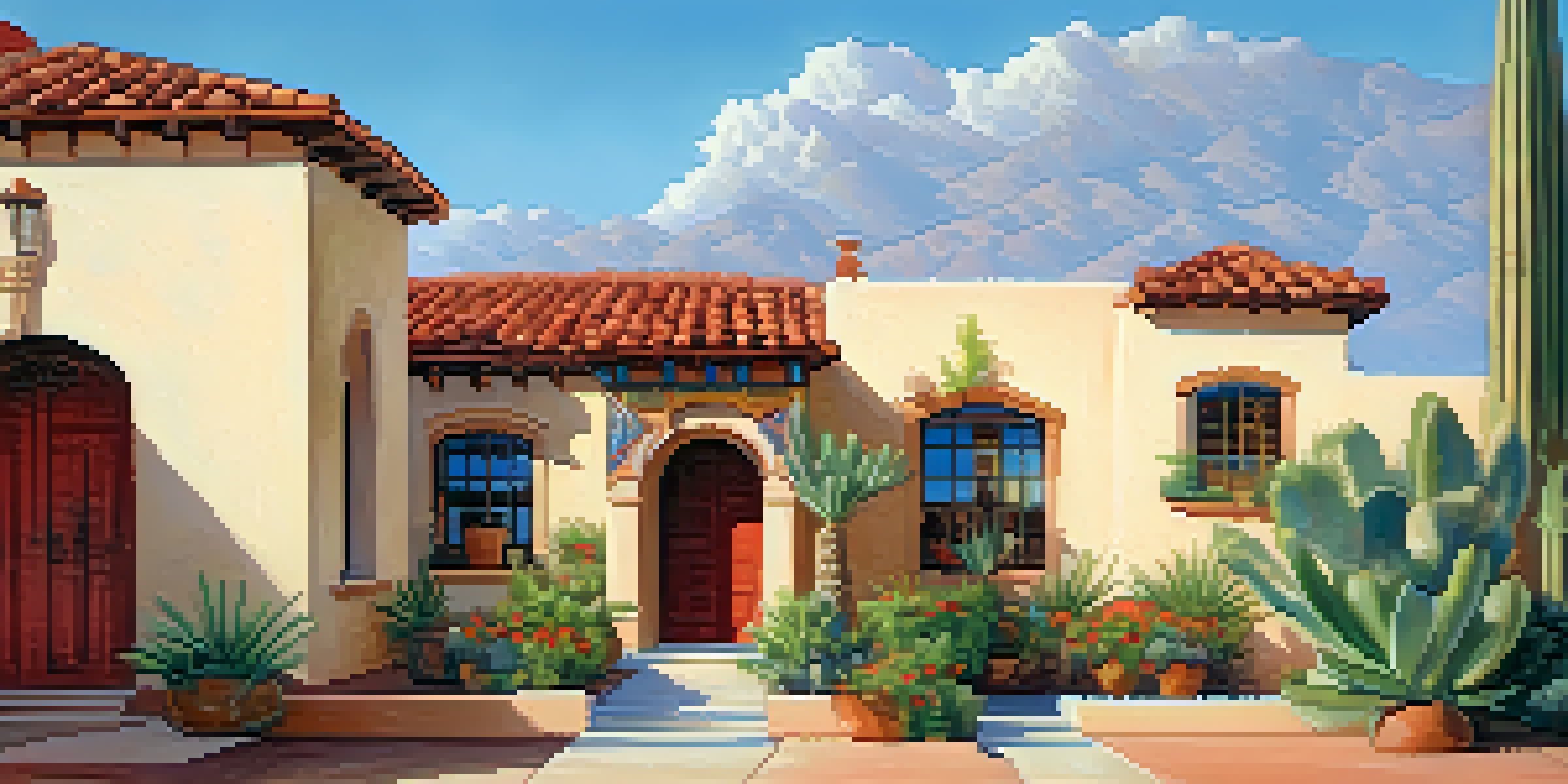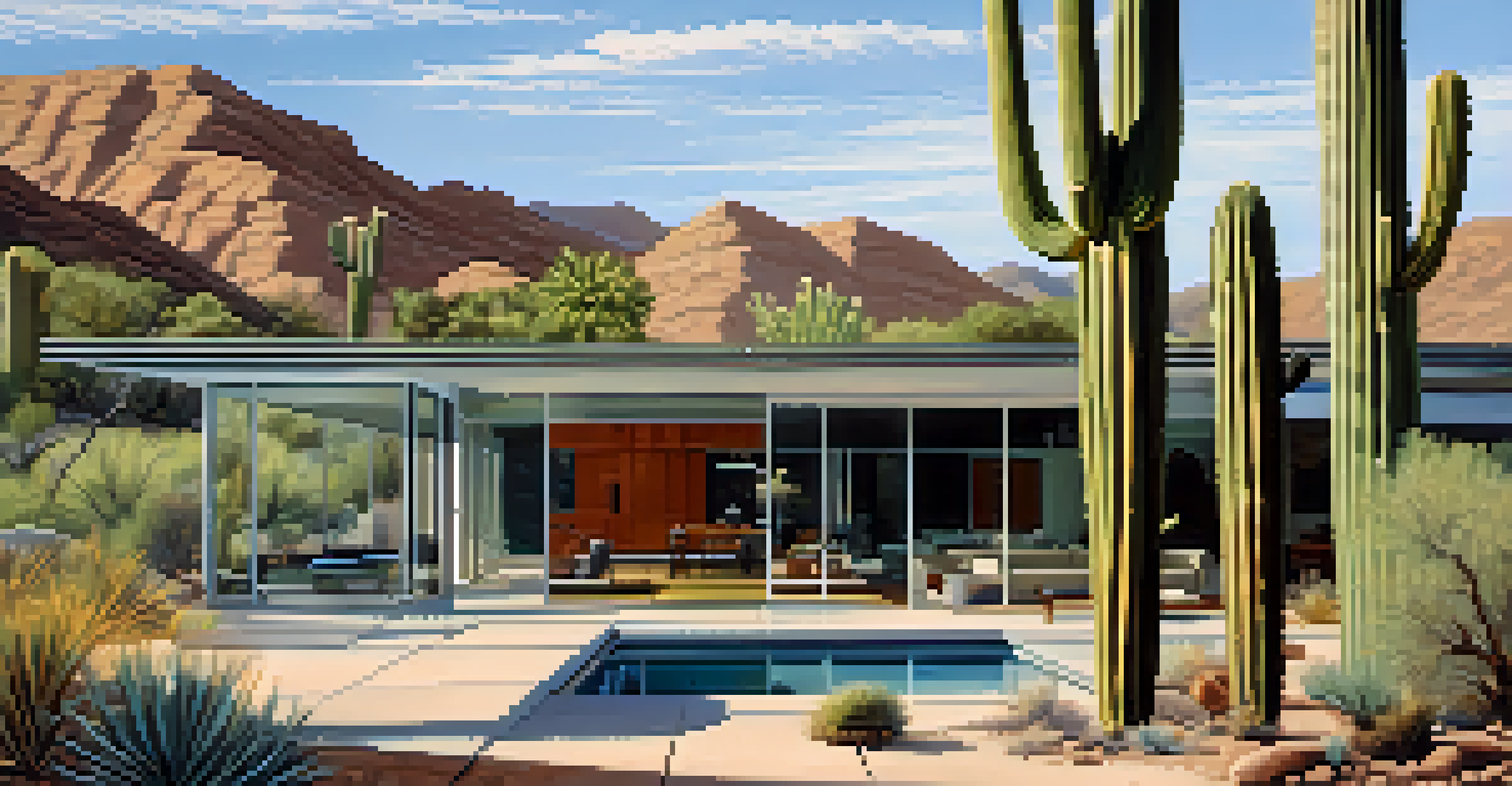Architectural Styles in Tucson's Historic Neighborhoods

An Overview of Tucson's Architectural Heritage
Tucson's architectural landscape is a captivating blend of styles, reflecting its rich history and cultural influences. From Spanish colonial to mid-century modern, each neighborhood tells a unique story through its buildings. This diversity not only enhances the visual appeal of the city but also provides a glimpse into the lives and values of its past residents.
Architecture is a visual art, and the buildings speak for themselves.
The city's architecture has been shaped by various factors, including climate, geography, and cultural exchange. For instance, the use of adobe in many homes is a response to the desert environment, offering natural insulation. As you stroll through Tucson's historic neighborhoods, you'll notice how these elements come together to create a cohesive yet varied architectural tapestry.
Understanding Tucson's architectural heritage is crucial for appreciating its historical significance. Each style, whether it's the intricate details of Mission Revival or the clean lines of Ranch-style homes, represents a different era in the city’s evolution. This exploration not only enriches our appreciation of the city but also fosters a sense of connection to its past.
Spanish Colonial Revival: A Timeless Influence
The Spanish Colonial Revival style is a defining characteristic of Tucson's architectural landscape. This style emerged in the early 20th century, drawing inspiration from the region's Spanish colonial roots. With features like stucco exteriors, red-tiled roofs, and arched doorways, homes in this style evoke a sense of warmth and history.

As you wander through neighborhoods like Sam Hughes, you'll encounter stunning examples of this architectural style. The blending of indoor and outdoor spaces, along with colorful tile work, creates a welcoming atmosphere that reflects the Southwest's vibrant culture. These homes often incorporate lush courtyards, serving as serene retreats from the bustling streets.
Tucson's Architectural Diversity
Tucson's neighborhoods showcase a rich blend of architectural styles, reflecting the city's history and cultural influences.
The Spanish Colonial Revival style not only enhances Tucson's charm but also serves as a reminder of the city's rich cultural heritage. It highlights the importance of preserving historical architecture while adapting to modern living. This style continues to inspire contemporary designs, ensuring that Tucson's architectural legacy thrives for future generations.
Mission Revival: A Symbol of Heritage
Mission Revival architecture is another significant style found in Tucson's historic neighborhoods. Originating in the late 19th century, this style pays homage to the Spanish missions established in the region. Characterized by its adobe walls, arched windows, and bell towers, Mission Revival embodies the spirit of Tucson's early settlers.
The architecture of a city is a reflection of its culture and history.
Neighborhoods like El Presidio showcase stunning examples of Mission Revival buildings that capture the essence of Tucson’s historical narrative. The earthy tones and decorative details create a sense of harmony with the surrounding desert landscape. This style not only enhances the aesthetic appeal but also serves as a testament to the city's enduring cultural identity.
As the city continues to evolve, the preservation of Mission Revival structures remains essential. These buildings provide a tangible link to Tucson’s past, reminding us of the traditions that shaped the community. By valuing this architectural style, we honor the stories and experiences of those who came before us.
Bungalow and Craftsman Styles: A Warm Embrace
The Bungalow and Craftsman architectural styles gained popularity in Tucson during the early 20th century. These homes are known for their low-pitched rooflines, wide porches, and handcrafted details that exude a cozy charm. As you explore neighborhoods like West University, you'll find delightful examples of these styles that invite you to slow down and appreciate the craftsmanship.
These homes often feature built-in furniture and natural materials, promoting a connection to the outdoors. The emphasis on simplicity and functionality in Bungalow design reflects a shift towards more casual living. This style encourages community interaction, as wide porches serve as gathering spaces for families and neighbors alike.
Preservation is Key
Safeguarding Tucson's diverse architectural heritage is essential for maintaining the city's unique character and historical significance.
The Bungalow and Craftsman homes in Tucson represent a departure from the ornate designs of earlier eras, focusing instead on comfort and livability. Their enduring appeal lies in their ability to blend seamlessly with the desert landscape while offering a sense of belonging. These architectural gems continue to inspire contemporary homeowners seeking a touch of history in their own designs.
Mid-Century Modern: Embracing Innovation
Mid-century modern architecture emerged in Tucson during the post-World War II era, bringing a fresh perspective to design. Characterized by clean lines, large windows, and open floor plans, this style reflects a desire for innovation and connection to nature. Neighborhoods like Catalina Vista showcase stunning examples of this architectural movement that resonates with today’s aesthetic preferences.
The use of new materials such as steel and glass allowed for greater experimentation in design. Mid-century modern homes often blur the lines between indoor and outdoor spaces, creating a seamless flow that enhances the living experience. This openness not only maximizes natural light but also invites the beauty of the surrounding desert landscape indoors.
As Tucson continues to grow, the preservation of mid-century modern architecture remains essential. These homes represent a pivotal moment in architectural history, celebrating creativity and functionality. By appreciating and maintaining these structures, we honor the innovative spirit that has shaped Tucson's identity.
Ranch-Style Homes: A Reflection of American Life
Ranch-style homes became a popular architectural choice in Tucson during the mid-20th century, reflecting the American lifestyle of the time. Known for their single-story layout, open spaces, and integration with the landscape, these homes were designed for comfort and ease of living. Neighborhoods like Palo Verde feature charming examples that echo the values of post-war America.
The design of ranch-style homes promotes a sense of casual living, with large windows that connect residents to the outdoors. Many of these homes include expansive backyards, perfect for family gatherings and barbecues. This emphasis on outdoor living aligns with Tucson's sunny climate, making it an ideal choice for families looking to enjoy their surroundings.
Connecting with Community Heritage
Exploring Tucson's architectural styles fosters a deeper connection to the community's roots and collective identity.
As the years go by, ranch-style homes continue to hold a special place in Tucson's architectural narrative. Their simplicity and functionality resonate with homeowners seeking a blend of modern amenities and historical charm. By preserving these iconic structures, we celebrate a unique chapter in Tucson's rich architectural history.
Preserving Tucson's Architectural Diversity
The preservation of Tucson's diverse architectural styles is crucial for maintaining the city's unique character. As development pressures increase, it's essential to safeguard these historic neighborhoods and the stories they tell. Community efforts, such as local preservation organizations, play a vital role in advocating for the protection of these architectural treasures.
By promoting awareness and appreciation for Tucson's architectural heritage, residents can help ensure that future generations can enjoy these vibrant neighborhoods. Engaging with local history fosters a deeper understanding of the community’s roots, encouraging pride in its diverse architectural legacy. It’s not just about preserving buildings; it’s about preserving the essence of Tucson.

As you explore the city, take the time to appreciate the rich architectural styles that define Tucson's neighborhoods. Each structure is a piece of history, contributing to the overall narrative of the city. By valuing and preserving these diverse styles, we honor the past while paving the way for a vibrant future.
Conclusion: Embracing Tucson's Architectural Legacy
Tucson's historic neighborhoods are a treasure trove of architectural styles that reflect the city's rich history and cultural diversity. From the enchanting Spanish Colonial Revival to the innovative mid-century modern, each style offers a glimpse into the past while shaping the present. Exploring these neighborhoods is not just an architectural journey; it's an opportunity to connect with the community's heritage.
As we appreciate the unique features of each style, we also recognize the importance of preservation. By valuing these architectural gems, we ensure that future generations can experience the beauty and stories embedded in Tucson's landscape. It's a collective responsibility to protect and celebrate the city's architectural legacy.
In embracing Tucson's architectural diversity, we foster a deeper connection to our community. Whether you're a long-time resident or a visitor, take the time to explore these historic neighborhoods. You might just find a new appreciation for the artistry and history that surround you.